Lean Project Management Strategies for FIFA 2022 World Cup Qatar
VerifiedAdded on 2023/04/21
|13
|4604
|145
Report
AI Summary
This report analyzes the application of Lean Project Management (PM) principles to the FIFA 2022 World Cup in Qatar, addressing concerns about the event's viability due to weather conditions. It details project management practices, stakeholder management using PMBOK and PRINCE2 methodologies, and the implementation of lean strategies such as waste elimination, consumer focus, and value stream identification. The report emphasizes the importance of stakeholder engagement, communication, and time management, while also discussing methodologies like DMAIC and agile practices. Ultimately, it highlights how lean PM can ensure the successful execution of the FIFA 2022 World Cup by optimizing resources, reducing waste, and meeting consumer expectations within allocated time and budget.
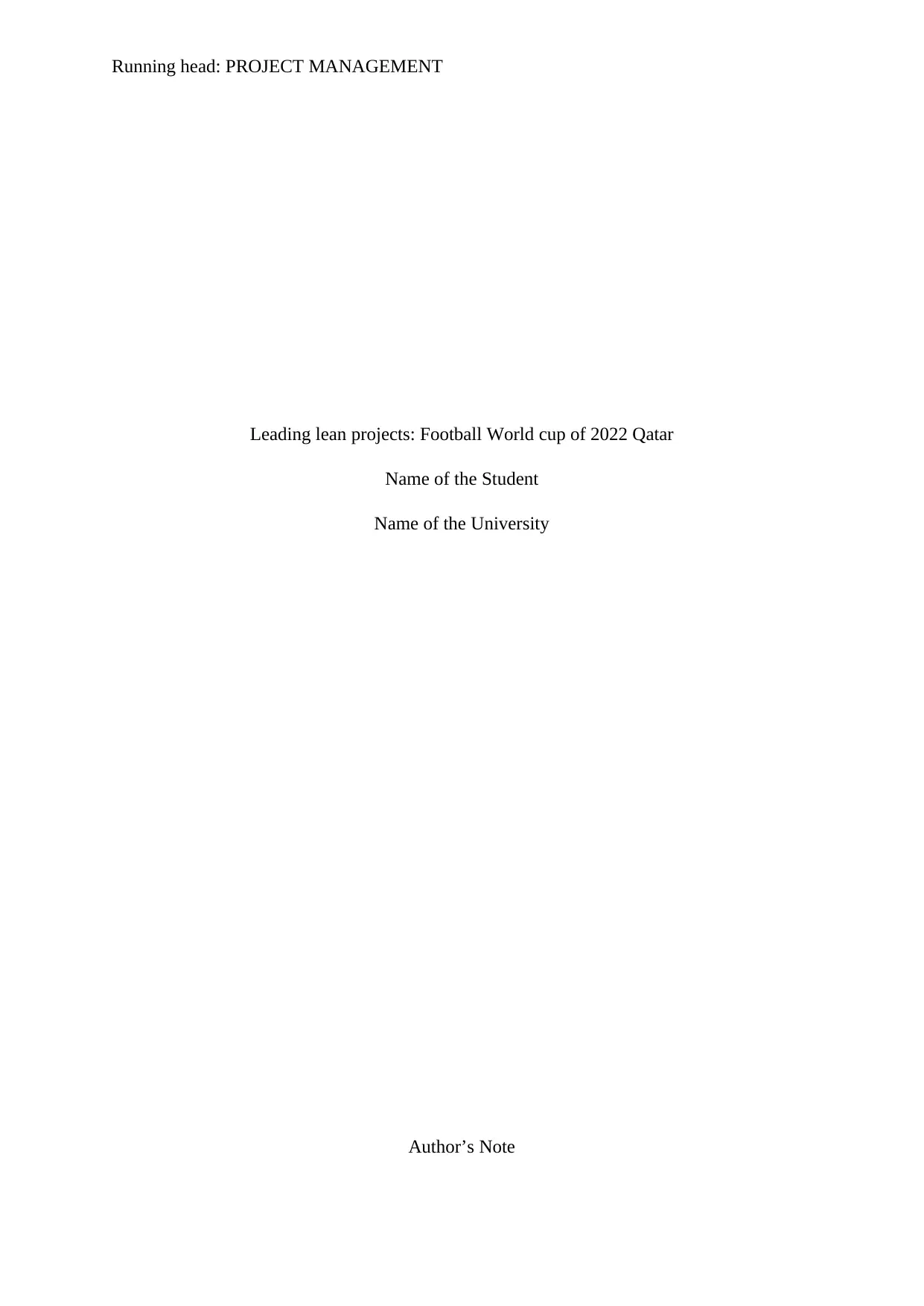
Running head: PROJECT MANAGEMENT
Leading lean projects: Football World cup of 2022 Qatar
Name of the Student
Name of the University
Author’s Note
Leading lean projects: Football World cup of 2022 Qatar
Name of the Student
Name of the University
Author’s Note
Paraphrase This Document
Need a fresh take? Get an instant paraphrase of this document with our AI Paraphraser
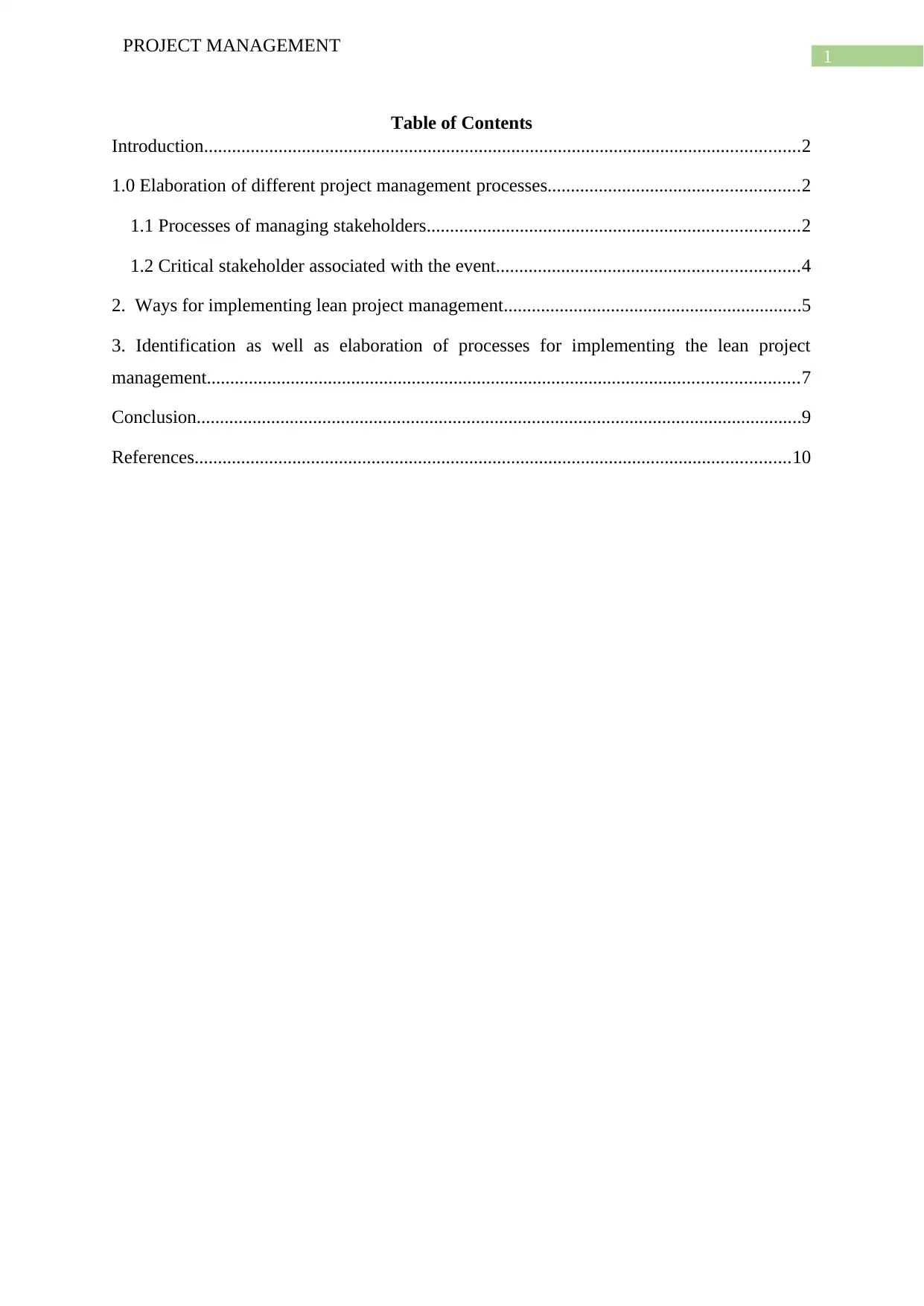
1
PROJECT MANAGEMENT
Table of Contents
Introduction................................................................................................................................2
1.0 Elaboration of different project management processes......................................................2
1.1 Processes of managing stakeholders................................................................................2
1.2 Critical stakeholder associated with the event.................................................................4
2. Ways for implementing lean project management................................................................5
3. Identification as well as elaboration of processes for implementing the lean project
management...............................................................................................................................7
Conclusion..................................................................................................................................9
References................................................................................................................................10
PROJECT MANAGEMENT
Table of Contents
Introduction................................................................................................................................2
1.0 Elaboration of different project management processes......................................................2
1.1 Processes of managing stakeholders................................................................................2
1.2 Critical stakeholder associated with the event.................................................................4
2. Ways for implementing lean project management................................................................5
3. Identification as well as elaboration of processes for implementing the lean project
management...............................................................................................................................7
Conclusion..................................................................................................................................9
References................................................................................................................................10
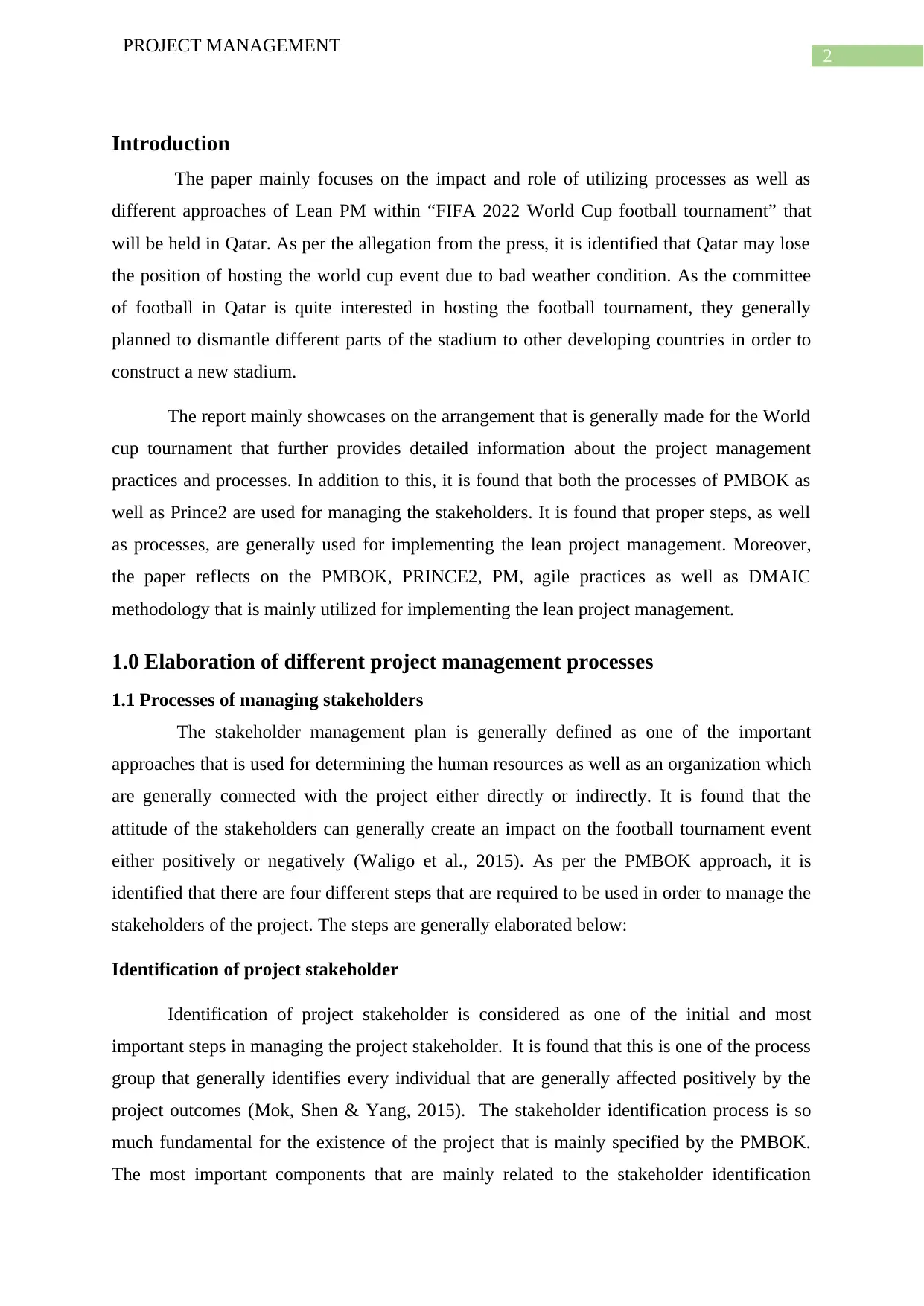
2
PROJECT MANAGEMENT
Introduction
The paper mainly focuses on the impact and role of utilizing processes as well as
different approaches of Lean PM within “FIFA 2022 World Cup football tournament” that
will be held in Qatar. As per the allegation from the press, it is identified that Qatar may lose
the position of hosting the world cup event due to bad weather condition. As the committee
of football in Qatar is quite interested in hosting the football tournament, they generally
planned to dismantle different parts of the stadium to other developing countries in order to
construct a new stadium.
The report mainly showcases on the arrangement that is generally made for the World
cup tournament that further provides detailed information about the project management
practices and processes. In addition to this, it is found that both the processes of PMBOK as
well as Prince2 are used for managing the stakeholders. It is found that proper steps, as well
as processes, are generally used for implementing the lean project management. Moreover,
the paper reflects on the PMBOK, PRINCE2, PM, agile practices as well as DMAIC
methodology that is mainly utilized for implementing the lean project management.
1.0 Elaboration of different project management processes
1.1 Processes of managing stakeholders
The stakeholder management plan is generally defined as one of the important
approaches that is used for determining the human resources as well as an organization which
are generally connected with the project either directly or indirectly. It is found that the
attitude of the stakeholders can generally create an impact on the football tournament event
either positively or negatively (Waligo et al., 2015). As per the PMBOK approach, it is
identified that there are four different steps that are required to be used in order to manage the
stakeholders of the project. The steps are generally elaborated below:
Identification of project stakeholder
Identification of project stakeholder is considered as one of the initial and most
important steps in managing the project stakeholder. It is found that this is one of the process
group that generally identifies every individual that are generally affected positively by the
project outcomes (Mok, Shen & Yang, 2015). The stakeholder identification process is so
much fundamental for the existence of the project that is mainly specified by the PMBOK.
The most important components that are mainly related to the stakeholder identification
PROJECT MANAGEMENT
Introduction
The paper mainly focuses on the impact and role of utilizing processes as well as
different approaches of Lean PM within “FIFA 2022 World Cup football tournament” that
will be held in Qatar. As per the allegation from the press, it is identified that Qatar may lose
the position of hosting the world cup event due to bad weather condition. As the committee
of football in Qatar is quite interested in hosting the football tournament, they generally
planned to dismantle different parts of the stadium to other developing countries in order to
construct a new stadium.
The report mainly showcases on the arrangement that is generally made for the World
cup tournament that further provides detailed information about the project management
practices and processes. In addition to this, it is found that both the processes of PMBOK as
well as Prince2 are used for managing the stakeholders. It is found that proper steps, as well
as processes, are generally used for implementing the lean project management. Moreover,
the paper reflects on the PMBOK, PRINCE2, PM, agile practices as well as DMAIC
methodology that is mainly utilized for implementing the lean project management.
1.0 Elaboration of different project management processes
1.1 Processes of managing stakeholders
The stakeholder management plan is generally defined as one of the important
approaches that is used for determining the human resources as well as an organization which
are generally connected with the project either directly or indirectly. It is found that the
attitude of the stakeholders can generally create an impact on the football tournament event
either positively or negatively (Waligo et al., 2015). As per the PMBOK approach, it is
identified that there are four different steps that are required to be used in order to manage the
stakeholders of the project. The steps are generally elaborated below:
Identification of project stakeholder
Identification of project stakeholder is considered as one of the initial and most
important steps in managing the project stakeholder. It is found that this is one of the process
group that generally identifies every individual that are generally affected positively by the
project outcomes (Mok, Shen & Yang, 2015). The stakeholder identification process is so
much fundamental for the existence of the project that is mainly specified by the PMBOK.
The most important components that are mainly related to the stakeholder identification
⊘ This is a preview!⊘
Do you want full access?
Subscribe today to unlock all pages.

Trusted by 1+ million students worldwide
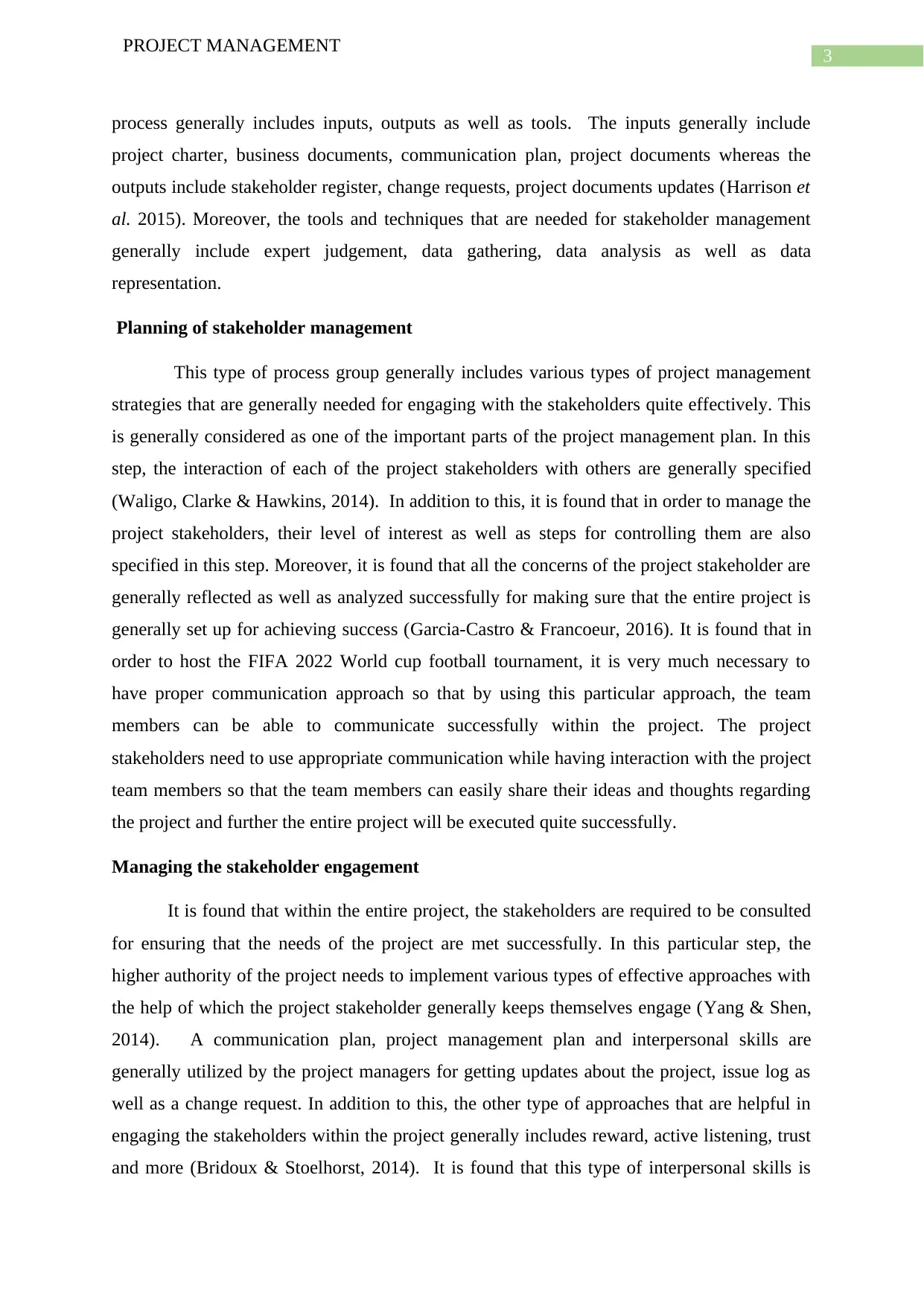
3
PROJECT MANAGEMENT
process generally includes inputs, outputs as well as tools. The inputs generally include
project charter, business documents, communication plan, project documents whereas the
outputs include stakeholder register, change requests, project documents updates (Harrison et
al. 2015). Moreover, the tools and techniques that are needed for stakeholder management
generally include expert judgement, data gathering, data analysis as well as data
representation.
Planning of stakeholder management
This type of process group generally includes various types of project management
strategies that are generally needed for engaging with the stakeholders quite effectively. This
is generally considered as one of the important parts of the project management plan. In this
step, the interaction of each of the project stakeholders with others are generally specified
(Waligo, Clarke & Hawkins, 2014). In addition to this, it is found that in order to manage the
project stakeholders, their level of interest as well as steps for controlling them are also
specified in this step. Moreover, it is found that all the concerns of the project stakeholder are
generally reflected as well as analyzed successfully for making sure that the entire project is
generally set up for achieving success (Garcia‐Castro & Francoeur, 2016). It is found that in
order to host the FIFA 2022 World cup football tournament, it is very much necessary to
have proper communication approach so that by using this particular approach, the team
members can be able to communicate successfully within the project. The project
stakeholders need to use appropriate communication while having interaction with the project
team members so that the team members can easily share their ideas and thoughts regarding
the project and further the entire project will be executed quite successfully.
Managing the stakeholder engagement
It is found that within the entire project, the stakeholders are required to be consulted
for ensuring that the needs of the project are met successfully. In this particular step, the
higher authority of the project needs to implement various types of effective approaches with
the help of which the project stakeholder generally keeps themselves engage (Yang & Shen,
2014). A communication plan, project management plan and interpersonal skills are
generally utilized by the project managers for getting updates about the project, issue log as
well as a change request. In addition to this, the other type of approaches that are helpful in
engaging the stakeholders within the project generally includes reward, active listening, trust
and more (Bridoux & Stoelhorst, 2014). It is found that this type of interpersonal skills is
PROJECT MANAGEMENT
process generally includes inputs, outputs as well as tools. The inputs generally include
project charter, business documents, communication plan, project documents whereas the
outputs include stakeholder register, change requests, project documents updates (Harrison et
al. 2015). Moreover, the tools and techniques that are needed for stakeholder management
generally include expert judgement, data gathering, data analysis as well as data
representation.
Planning of stakeholder management
This type of process group generally includes various types of project management
strategies that are generally needed for engaging with the stakeholders quite effectively. This
is generally considered as one of the important parts of the project management plan. In this
step, the interaction of each of the project stakeholders with others are generally specified
(Waligo, Clarke & Hawkins, 2014). In addition to this, it is found that in order to manage the
project stakeholders, their level of interest as well as steps for controlling them are also
specified in this step. Moreover, it is found that all the concerns of the project stakeholder are
generally reflected as well as analyzed successfully for making sure that the entire project is
generally set up for achieving success (Garcia‐Castro & Francoeur, 2016). It is found that in
order to host the FIFA 2022 World cup football tournament, it is very much necessary to
have proper communication approach so that by using this particular approach, the team
members can be able to communicate successfully within the project. The project
stakeholders need to use appropriate communication while having interaction with the project
team members so that the team members can easily share their ideas and thoughts regarding
the project and further the entire project will be executed quite successfully.
Managing the stakeholder engagement
It is found that within the entire project, the stakeholders are required to be consulted
for ensuring that the needs of the project are met successfully. In this particular step, the
higher authority of the project needs to implement various types of effective approaches with
the help of which the project stakeholder generally keeps themselves engage (Yang & Shen,
2014). A communication plan, project management plan and interpersonal skills are
generally utilized by the project managers for getting updates about the project, issue log as
well as a change request. In addition to this, the other type of approaches that are helpful in
engaging the stakeholders within the project generally includes reward, active listening, trust
and more (Bridoux & Stoelhorst, 2014). It is found that this type of interpersonal skills is
Paraphrase This Document
Need a fresh take? Get an instant paraphrase of this document with our AI Paraphraser
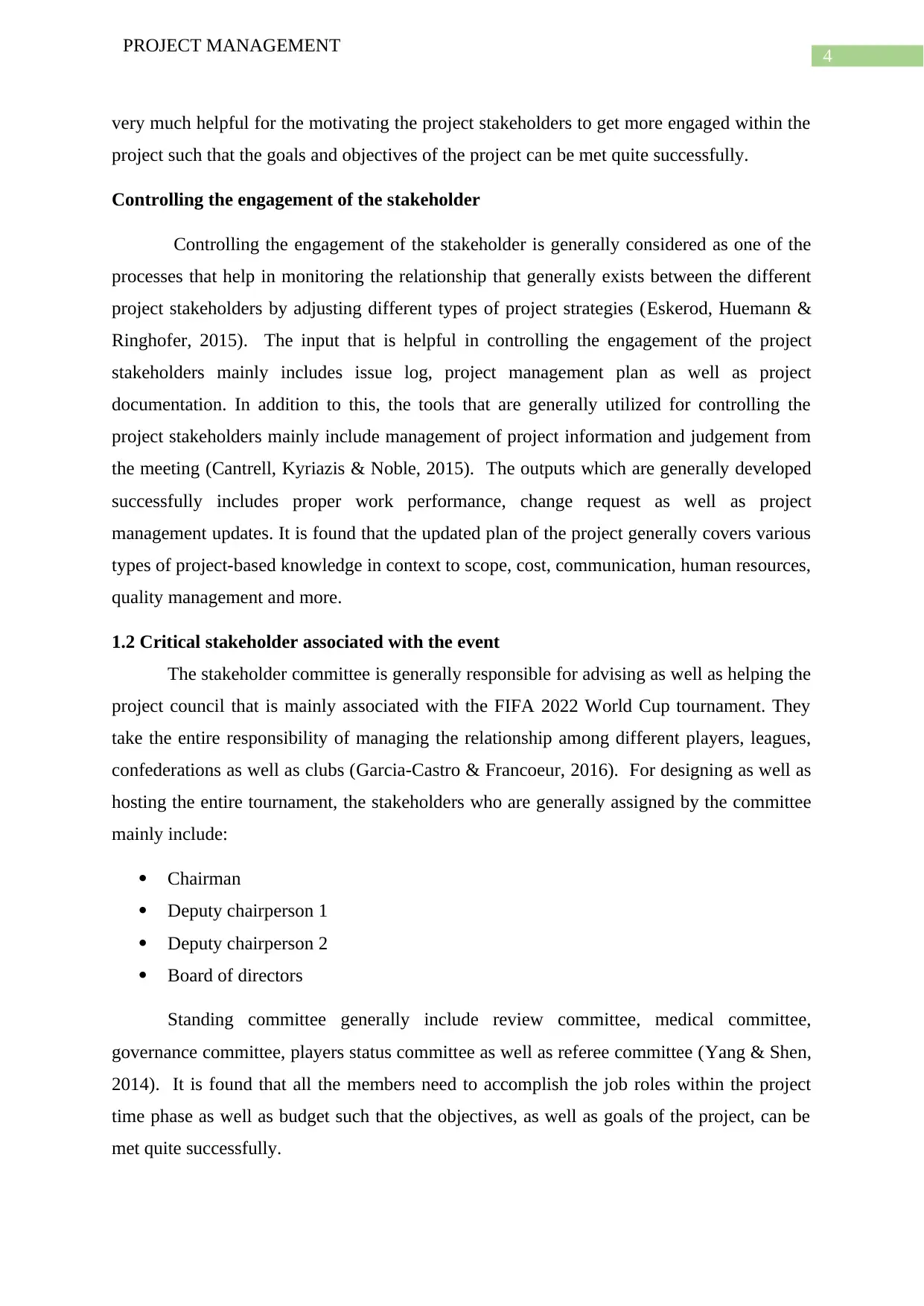
4
PROJECT MANAGEMENT
very much helpful for the motivating the project stakeholders to get more engaged within the
project such that the goals and objectives of the project can be met quite successfully.
Controlling the engagement of the stakeholder
Controlling the engagement of the stakeholder is generally considered as one of the
processes that help in monitoring the relationship that generally exists between the different
project stakeholders by adjusting different types of project strategies (Eskerod, Huemann &
Ringhofer, 2015). The input that is helpful in controlling the engagement of the project
stakeholders mainly includes issue log, project management plan as well as project
documentation. In addition to this, the tools that are generally utilized for controlling the
project stakeholders mainly include management of project information and judgement from
the meeting (Cantrell, Kyriazis & Noble, 2015). The outputs which are generally developed
successfully includes proper work performance, change request as well as project
management updates. It is found that the updated plan of the project generally covers various
types of project-based knowledge in context to scope, cost, communication, human resources,
quality management and more.
1.2 Critical stakeholder associated with the event
The stakeholder committee is generally responsible for advising as well as helping the
project council that is mainly associated with the FIFA 2022 World Cup tournament. They
take the entire responsibility of managing the relationship among different players, leagues,
confederations as well as clubs (Garcia‐Castro & Francoeur, 2016). For designing as well as
hosting the entire tournament, the stakeholders who are generally assigned by the committee
mainly include:
Chairman
Deputy chairperson 1
Deputy chairperson 2
Board of directors
Standing committee generally include review committee, medical committee,
governance committee, players status committee as well as referee committee (Yang & Shen,
2014). It is found that all the members need to accomplish the job roles within the project
time phase as well as budget such that the objectives, as well as goals of the project, can be
met quite successfully.
PROJECT MANAGEMENT
very much helpful for the motivating the project stakeholders to get more engaged within the
project such that the goals and objectives of the project can be met quite successfully.
Controlling the engagement of the stakeholder
Controlling the engagement of the stakeholder is generally considered as one of the
processes that help in monitoring the relationship that generally exists between the different
project stakeholders by adjusting different types of project strategies (Eskerod, Huemann &
Ringhofer, 2015). The input that is helpful in controlling the engagement of the project
stakeholders mainly includes issue log, project management plan as well as project
documentation. In addition to this, the tools that are generally utilized for controlling the
project stakeholders mainly include management of project information and judgement from
the meeting (Cantrell, Kyriazis & Noble, 2015). The outputs which are generally developed
successfully includes proper work performance, change request as well as project
management updates. It is found that the updated plan of the project generally covers various
types of project-based knowledge in context to scope, cost, communication, human resources,
quality management and more.
1.2 Critical stakeholder associated with the event
The stakeholder committee is generally responsible for advising as well as helping the
project council that is mainly associated with the FIFA 2022 World Cup tournament. They
take the entire responsibility of managing the relationship among different players, leagues,
confederations as well as clubs (Garcia‐Castro & Francoeur, 2016). For designing as well as
hosting the entire tournament, the stakeholders who are generally assigned by the committee
mainly include:
Chairman
Deputy chairperson 1
Deputy chairperson 2
Board of directors
Standing committee generally include review committee, medical committee,
governance committee, players status committee as well as referee committee (Yang & Shen,
2014). It is found that all the members need to accomplish the job roles within the project
time phase as well as budget such that the objectives, as well as goals of the project, can be
met quite successfully.
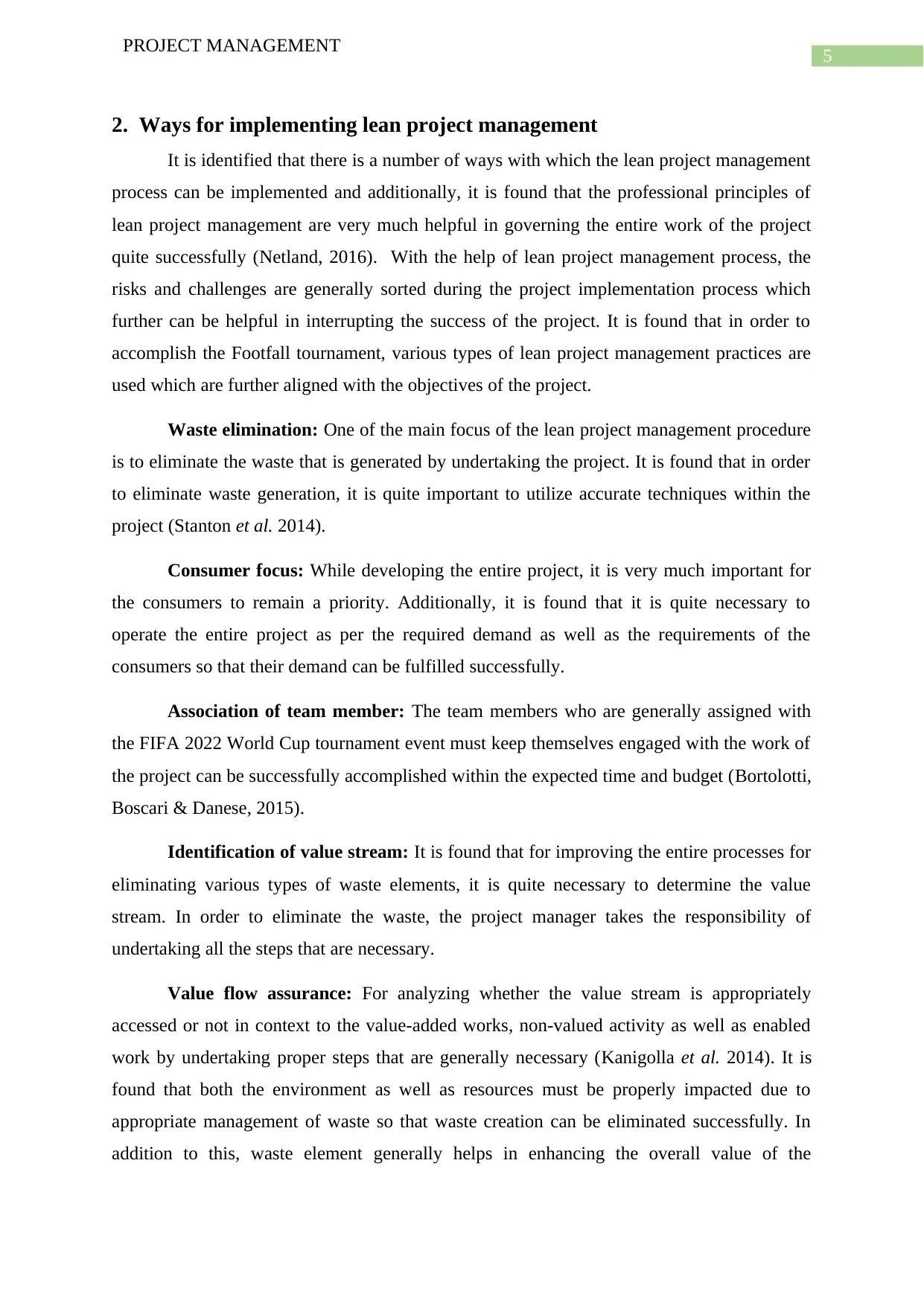
5
PROJECT MANAGEMENT
2. Ways for implementing lean project management
It is identified that there is a number of ways with which the lean project management
process can be implemented and additionally, it is found that the professional principles of
lean project management are very much helpful in governing the entire work of the project
quite successfully (Netland, 2016). With the help of lean project management process, the
risks and challenges are generally sorted during the project implementation process which
further can be helpful in interrupting the success of the project. It is found that in order to
accomplish the Footfall tournament, various types of lean project management practices are
used which are further aligned with the objectives of the project.
Waste elimination: One of the main focus of the lean project management procedure
is to eliminate the waste that is generated by undertaking the project. It is found that in order
to eliminate waste generation, it is quite important to utilize accurate techniques within the
project (Stanton et al. 2014).
Consumer focus: While developing the entire project, it is very much important for
the consumers to remain a priority. Additionally, it is found that it is quite necessary to
operate the entire project as per the required demand as well as the requirements of the
consumers so that their demand can be fulfilled successfully.
Association of team member: The team members who are generally assigned with
the FIFA 2022 World Cup tournament event must keep themselves engaged with the work of
the project can be successfully accomplished within the expected time and budget (Bortolotti,
Boscari & Danese, 2015).
Identification of value stream: It is found that for improving the entire processes for
eliminating various types of waste elements, it is quite necessary to determine the value
stream. In order to eliminate the waste, the project manager takes the responsibility of
undertaking all the steps that are necessary.
Value flow assurance: For analyzing whether the value stream is appropriately
accessed or not in context to the value-added works, non-valued activity as well as enabled
work by undertaking proper steps that are generally necessary (Kanigolla et al. 2014). It is
found that both the environment as well as resources must be properly impacted due to
appropriate management of waste so that waste creation can be eliminated successfully. In
addition to this, waste element generally helps in enhancing the overall value of the
PROJECT MANAGEMENT
2. Ways for implementing lean project management
It is identified that there is a number of ways with which the lean project management
process can be implemented and additionally, it is found that the professional principles of
lean project management are very much helpful in governing the entire work of the project
quite successfully (Netland, 2016). With the help of lean project management process, the
risks and challenges are generally sorted during the project implementation process which
further can be helpful in interrupting the success of the project. It is found that in order to
accomplish the Footfall tournament, various types of lean project management practices are
used which are further aligned with the objectives of the project.
Waste elimination: One of the main focus of the lean project management procedure
is to eliminate the waste that is generated by undertaking the project. It is found that in order
to eliminate waste generation, it is quite important to utilize accurate techniques within the
project (Stanton et al. 2014).
Consumer focus: While developing the entire project, it is very much important for
the consumers to remain a priority. Additionally, it is found that it is quite necessary to
operate the entire project as per the required demand as well as the requirements of the
consumers so that their demand can be fulfilled successfully.
Association of team member: The team members who are generally assigned with
the FIFA 2022 World Cup tournament event must keep themselves engaged with the work of
the project can be successfully accomplished within the expected time and budget (Bortolotti,
Boscari & Danese, 2015).
Identification of value stream: It is found that for improving the entire processes for
eliminating various types of waste elements, it is quite necessary to determine the value
stream. In order to eliminate the waste, the project manager takes the responsibility of
undertaking all the steps that are necessary.
Value flow assurance: For analyzing whether the value stream is appropriately
accessed or not in context to the value-added works, non-valued activity as well as enabled
work by undertaking proper steps that are generally necessary (Kanigolla et al. 2014). It is
found that both the environment as well as resources must be properly impacted due to
appropriate management of waste so that waste creation can be eliminated successfully. In
addition to this, waste element generally helps in enhancing the overall value of the
⊘ This is a preview!⊘
Do you want full access?
Subscribe today to unlock all pages.

Trusted by 1+ million students worldwide
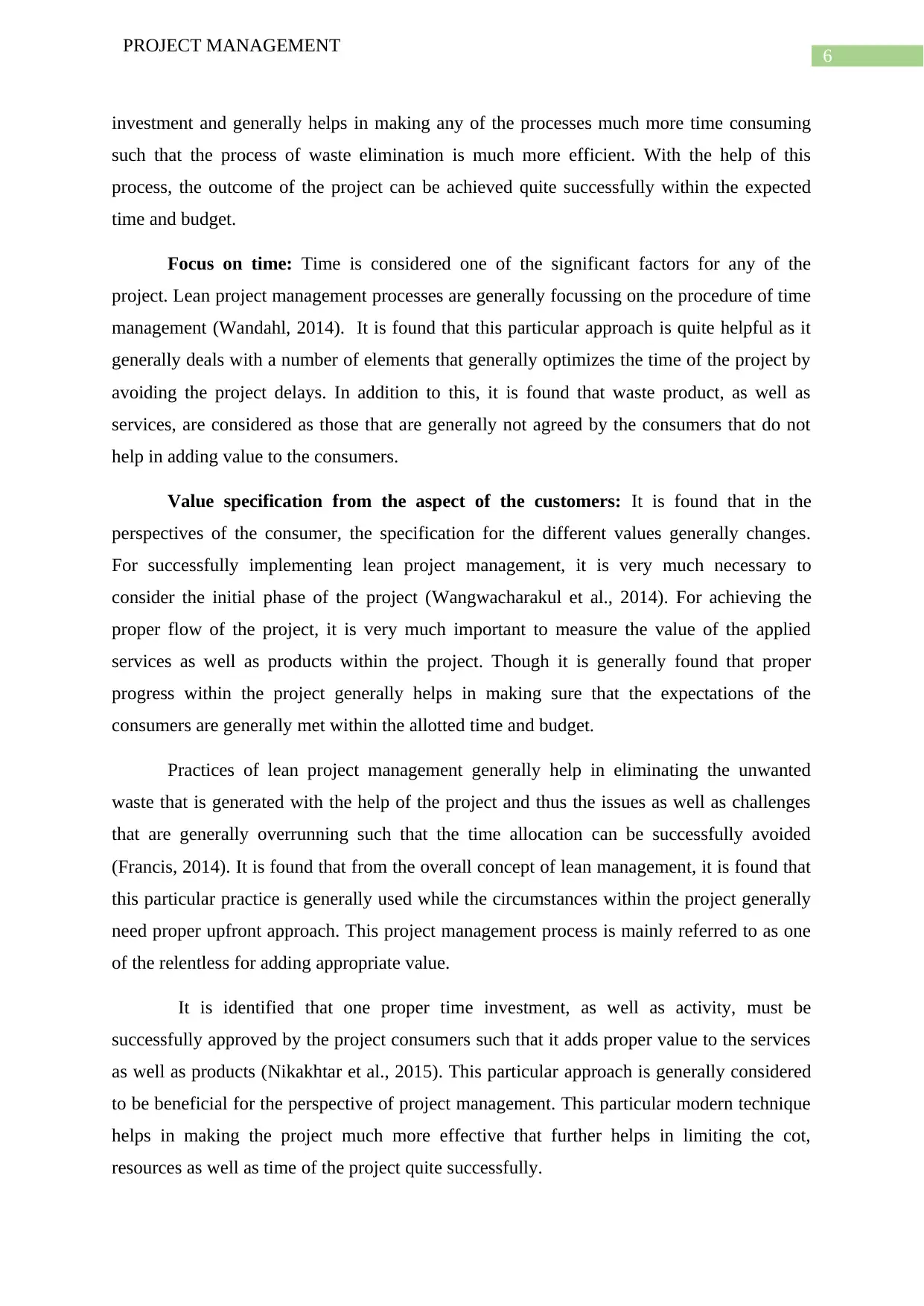
6
PROJECT MANAGEMENT
investment and generally helps in making any of the processes much more time consuming
such that the process of waste elimination is much more efficient. With the help of this
process, the outcome of the project can be achieved quite successfully within the expected
time and budget.
Focus on time: Time is considered one of the significant factors for any of the
project. Lean project management processes are generally focussing on the procedure of time
management (Wandahl, 2014). It is found that this particular approach is quite helpful as it
generally deals with a number of elements that generally optimizes the time of the project by
avoiding the project delays. In addition to this, it is found that waste product, as well as
services, are considered as those that are generally not agreed by the consumers that do not
help in adding value to the consumers.
Value specification from the aspect of the customers: It is found that in the
perspectives of the consumer, the specification for the different values generally changes.
For successfully implementing lean project management, it is very much necessary to
consider the initial phase of the project (Wangwacharakul et al., 2014). For achieving the
proper flow of the project, it is very much important to measure the value of the applied
services as well as products within the project. Though it is generally found that proper
progress within the project generally helps in making sure that the expectations of the
consumers are generally met within the allotted time and budget.
Practices of lean project management generally help in eliminating the unwanted
waste that is generated with the help of the project and thus the issues as well as challenges
that are generally overrunning such that the time allocation can be successfully avoided
(Francis, 2014). It is found that from the overall concept of lean management, it is found that
this particular practice is generally used while the circumstances within the project generally
need proper upfront approach. This project management process is mainly referred to as one
of the relentless for adding appropriate value.
It is identified that one proper time investment, as well as activity, must be
successfully approved by the project consumers such that it adds proper value to the services
as well as products (Nikakhtar et al., 2015). This particular approach is generally considered
to be beneficial for the perspective of project management. This particular modern technique
helps in making the project much more effective that further helps in limiting the cot,
resources as well as time of the project quite successfully.
PROJECT MANAGEMENT
investment and generally helps in making any of the processes much more time consuming
such that the process of waste elimination is much more efficient. With the help of this
process, the outcome of the project can be achieved quite successfully within the expected
time and budget.
Focus on time: Time is considered one of the significant factors for any of the
project. Lean project management processes are generally focussing on the procedure of time
management (Wandahl, 2014). It is found that this particular approach is quite helpful as it
generally deals with a number of elements that generally optimizes the time of the project by
avoiding the project delays. In addition to this, it is found that waste product, as well as
services, are considered as those that are generally not agreed by the consumers that do not
help in adding value to the consumers.
Value specification from the aspect of the customers: It is found that in the
perspectives of the consumer, the specification for the different values generally changes.
For successfully implementing lean project management, it is very much necessary to
consider the initial phase of the project (Wangwacharakul et al., 2014). For achieving the
proper flow of the project, it is very much important to measure the value of the applied
services as well as products within the project. Though it is generally found that proper
progress within the project generally helps in making sure that the expectations of the
consumers are generally met within the allotted time and budget.
Practices of lean project management generally help in eliminating the unwanted
waste that is generated with the help of the project and thus the issues as well as challenges
that are generally overrunning such that the time allocation can be successfully avoided
(Francis, 2014). It is found that from the overall concept of lean management, it is found that
this particular practice is generally used while the circumstances within the project generally
need proper upfront approach. This project management process is mainly referred to as one
of the relentless for adding appropriate value.
It is identified that one proper time investment, as well as activity, must be
successfully approved by the project consumers such that it adds proper value to the services
as well as products (Nikakhtar et al., 2015). This particular approach is generally considered
to be beneficial for the perspective of project management. This particular modern technique
helps in making the project much more effective that further helps in limiting the cot,
resources as well as time of the project quite successfully.
Paraphrase This Document
Need a fresh take? Get an instant paraphrase of this document with our AI Paraphraser
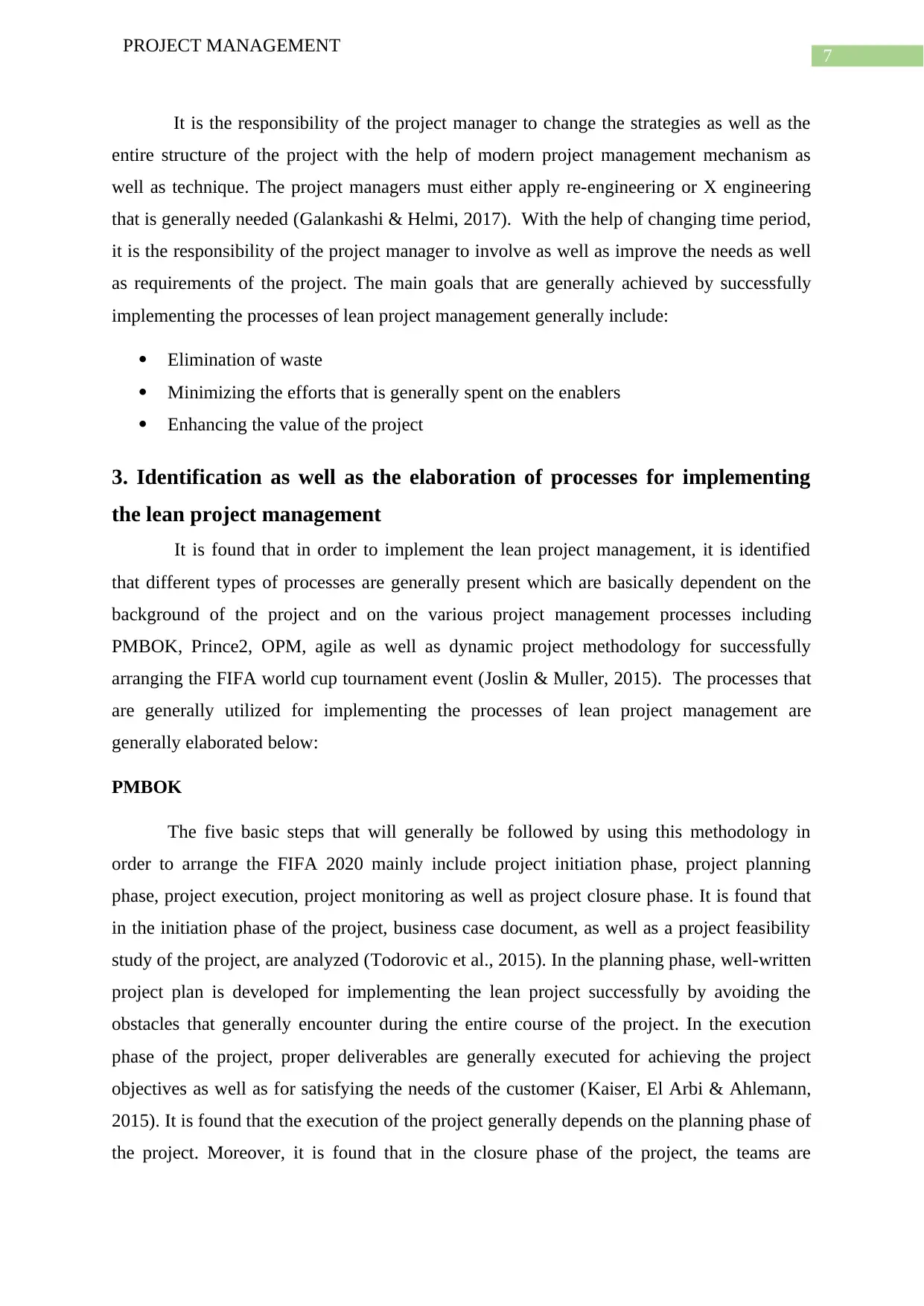
7
PROJECT MANAGEMENT
It is the responsibility of the project manager to change the strategies as well as the
entire structure of the project with the help of modern project management mechanism as
well as technique. The project managers must either apply re-engineering or X engineering
that is generally needed (Galankashi & Helmi, 2017). With the help of changing time period,
it is the responsibility of the project manager to involve as well as improve the needs as well
as requirements of the project. The main goals that are generally achieved by successfully
implementing the processes of lean project management generally include:
Elimination of waste
Minimizing the efforts that is generally spent on the enablers
Enhancing the value of the project
3. Identification as well as the elaboration of processes for implementing
the lean project management
It is found that in order to implement the lean project management, it is identified
that different types of processes are generally present which are basically dependent on the
background of the project and on the various project management processes including
PMBOK, Prince2, OPM, agile as well as dynamic project methodology for successfully
arranging the FIFA world cup tournament event (Joslin & Muller, 2015). The processes that
are generally utilized for implementing the processes of lean project management are
generally elaborated below:
PMBOK
The five basic steps that will generally be followed by using this methodology in
order to arrange the FIFA 2020 mainly include project initiation phase, project planning
phase, project execution, project monitoring as well as project closure phase. It is found that
in the initiation phase of the project, business case document, as well as a project feasibility
study of the project, are analyzed (Todorovic et al., 2015). In the planning phase, well-written
project plan is developed for implementing the lean project successfully by avoiding the
obstacles that generally encounter during the entire course of the project. In the execution
phase of the project, proper deliverables are generally executed for achieving the project
objectives as well as for satisfying the needs of the customer (Kaiser, El Arbi & Ahlemann,
2015). It is found that the execution of the project generally depends on the planning phase of
the project. Moreover, it is found that in the closure phase of the project, the teams are
PROJECT MANAGEMENT
It is the responsibility of the project manager to change the strategies as well as the
entire structure of the project with the help of modern project management mechanism as
well as technique. The project managers must either apply re-engineering or X engineering
that is generally needed (Galankashi & Helmi, 2017). With the help of changing time period,
it is the responsibility of the project manager to involve as well as improve the needs as well
as requirements of the project. The main goals that are generally achieved by successfully
implementing the processes of lean project management generally include:
Elimination of waste
Minimizing the efforts that is generally spent on the enablers
Enhancing the value of the project
3. Identification as well as the elaboration of processes for implementing
the lean project management
It is found that in order to implement the lean project management, it is identified
that different types of processes are generally present which are basically dependent on the
background of the project and on the various project management processes including
PMBOK, Prince2, OPM, agile as well as dynamic project methodology for successfully
arranging the FIFA world cup tournament event (Joslin & Muller, 2015). The processes that
are generally utilized for implementing the processes of lean project management are
generally elaborated below:
PMBOK
The five basic steps that will generally be followed by using this methodology in
order to arrange the FIFA 2020 mainly include project initiation phase, project planning
phase, project execution, project monitoring as well as project closure phase. It is found that
in the initiation phase of the project, business case document, as well as a project feasibility
study of the project, are analyzed (Todorovic et al., 2015). In the planning phase, well-written
project plan is developed for implementing the lean project successfully by avoiding the
obstacles that generally encounter during the entire course of the project. In the execution
phase of the project, proper deliverables are generally executed for achieving the project
objectives as well as for satisfying the needs of the customer (Kaiser, El Arbi & Ahlemann,
2015). It is found that the execution of the project generally depends on the planning phase of
the project. Moreover, it is found that in the closure phase of the project, the teams are
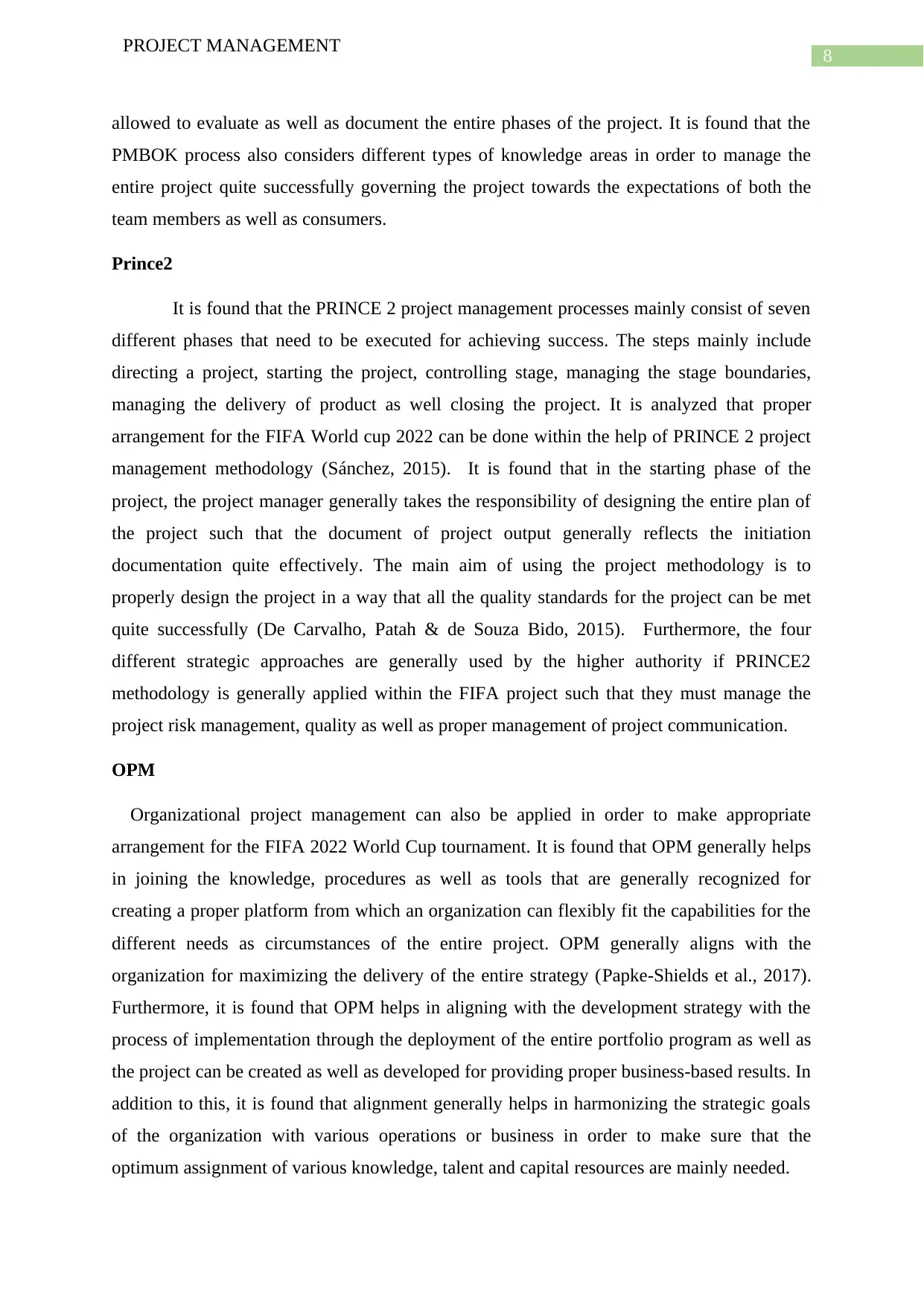
8
PROJECT MANAGEMENT
allowed to evaluate as well as document the entire phases of the project. It is found that the
PMBOK process also considers different types of knowledge areas in order to manage the
entire project quite successfully governing the project towards the expectations of both the
team members as well as consumers.
Prince2
It is found that the PRINCE 2 project management processes mainly consist of seven
different phases that need to be executed for achieving success. The steps mainly include
directing a project, starting the project, controlling stage, managing the stage boundaries,
managing the delivery of product as well closing the project. It is analyzed that proper
arrangement for the FIFA World cup 2022 can be done within the help of PRINCE 2 project
management methodology (Sánchez, 2015). It is found that in the starting phase of the
project, the project manager generally takes the responsibility of designing the entire plan of
the project such that the document of project output generally reflects the initiation
documentation quite effectively. The main aim of using the project methodology is to
properly design the project in a way that all the quality standards for the project can be met
quite successfully (De Carvalho, Patah & de Souza Bido, 2015). Furthermore, the four
different strategic approaches are generally used by the higher authority if PRINCE2
methodology is generally applied within the FIFA project such that they must manage the
project risk management, quality as well as proper management of project communication.
OPM
Organizational project management can also be applied in order to make appropriate
arrangement for the FIFA 2022 World Cup tournament. It is found that OPM generally helps
in joining the knowledge, procedures as well as tools that are generally recognized for
creating a proper platform from which an organization can flexibly fit the capabilities for the
different needs as circumstances of the entire project. OPM generally aligns with the
organization for maximizing the delivery of the entire strategy (Papke-Shields et al., 2017).
Furthermore, it is found that OPM helps in aligning with the development strategy with the
process of implementation through the deployment of the entire portfolio program as well as
the project can be created as well as developed for providing proper business-based results. In
addition to this, it is found that alignment generally helps in harmonizing the strategic goals
of the organization with various operations or business in order to make sure that the
optimum assignment of various knowledge, talent and capital resources are mainly needed.
PROJECT MANAGEMENT
allowed to evaluate as well as document the entire phases of the project. It is found that the
PMBOK process also considers different types of knowledge areas in order to manage the
entire project quite successfully governing the project towards the expectations of both the
team members as well as consumers.
Prince2
It is found that the PRINCE 2 project management processes mainly consist of seven
different phases that need to be executed for achieving success. The steps mainly include
directing a project, starting the project, controlling stage, managing the stage boundaries,
managing the delivery of product as well closing the project. It is analyzed that proper
arrangement for the FIFA World cup 2022 can be done within the help of PRINCE 2 project
management methodology (Sánchez, 2015). It is found that in the starting phase of the
project, the project manager generally takes the responsibility of designing the entire plan of
the project such that the document of project output generally reflects the initiation
documentation quite effectively. The main aim of using the project methodology is to
properly design the project in a way that all the quality standards for the project can be met
quite successfully (De Carvalho, Patah & de Souza Bido, 2015). Furthermore, the four
different strategic approaches are generally used by the higher authority if PRINCE2
methodology is generally applied within the FIFA project such that they must manage the
project risk management, quality as well as proper management of project communication.
OPM
Organizational project management can also be applied in order to make appropriate
arrangement for the FIFA 2022 World Cup tournament. It is found that OPM generally helps
in joining the knowledge, procedures as well as tools that are generally recognized for
creating a proper platform from which an organization can flexibly fit the capabilities for the
different needs as circumstances of the entire project. OPM generally aligns with the
organization for maximizing the delivery of the entire strategy (Papke-Shields et al., 2017).
Furthermore, it is found that OPM helps in aligning with the development strategy with the
process of implementation through the deployment of the entire portfolio program as well as
the project can be created as well as developed for providing proper business-based results. In
addition to this, it is found that alignment generally helps in harmonizing the strategic goals
of the organization with various operations or business in order to make sure that the
optimum assignment of various knowledge, talent and capital resources are mainly needed.
⊘ This is a preview!⊘
Do you want full access?
Subscribe today to unlock all pages.

Trusted by 1+ million students worldwide
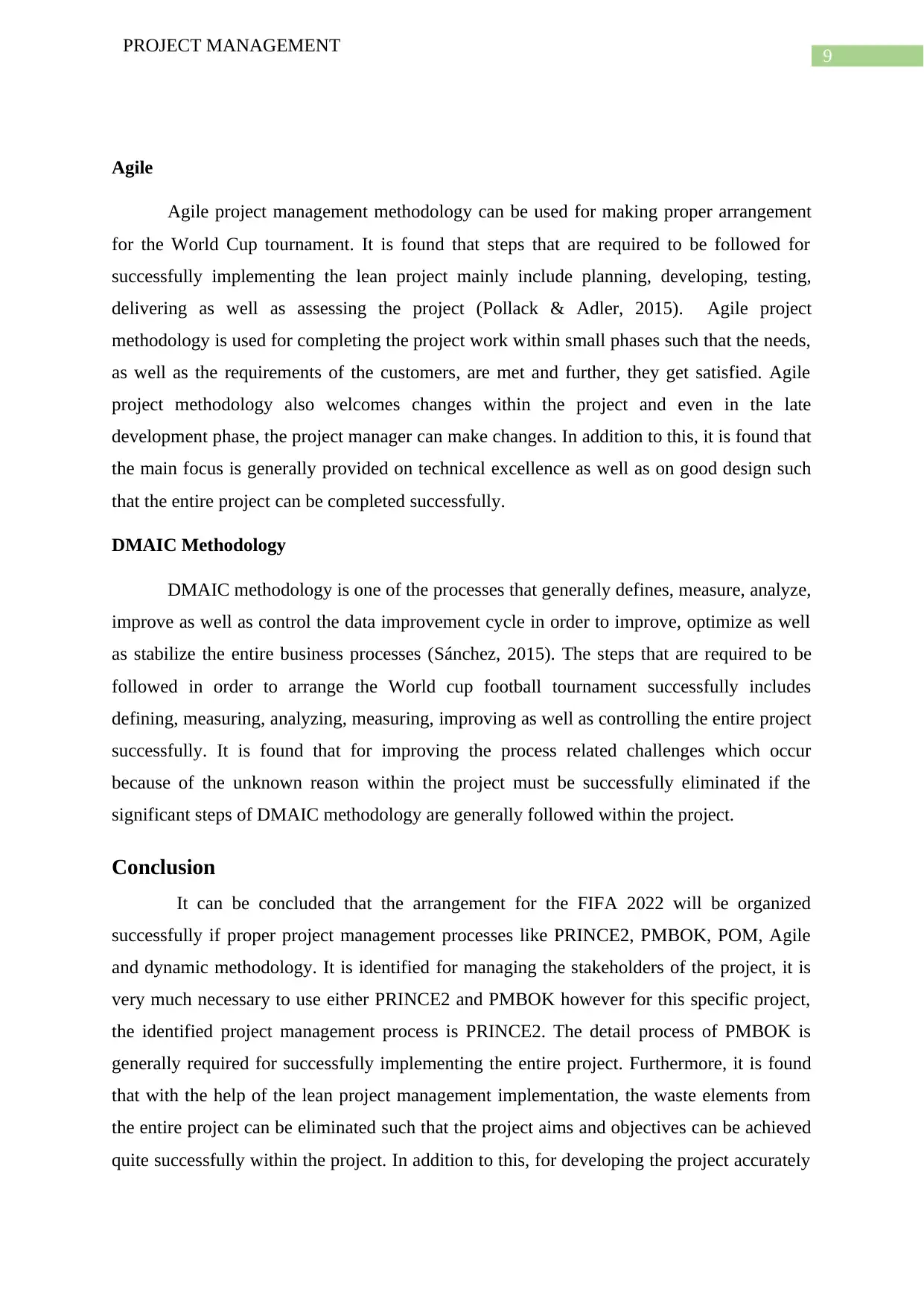
9
PROJECT MANAGEMENT
Agile
Agile project management methodology can be used for making proper arrangement
for the World Cup tournament. It is found that steps that are required to be followed for
successfully implementing the lean project mainly include planning, developing, testing,
delivering as well as assessing the project (Pollack & Adler, 2015). Agile project
methodology is used for completing the project work within small phases such that the needs,
as well as the requirements of the customers, are met and further, they get satisfied. Agile
project methodology also welcomes changes within the project and even in the late
development phase, the project manager can make changes. In addition to this, it is found that
the main focus is generally provided on technical excellence as well as on good design such
that the entire project can be completed successfully.
DMAIC Methodology
DMAIC methodology is one of the processes that generally defines, measure, analyze,
improve as well as control the data improvement cycle in order to improve, optimize as well
as stabilize the entire business processes (Sánchez, 2015). The steps that are required to be
followed in order to arrange the World cup football tournament successfully includes
defining, measuring, analyzing, measuring, improving as well as controlling the entire project
successfully. It is found that for improving the process related challenges which occur
because of the unknown reason within the project must be successfully eliminated if the
significant steps of DMAIC methodology are generally followed within the project.
Conclusion
It can be concluded that the arrangement for the FIFA 2022 will be organized
successfully if proper project management processes like PRINCE2, PMBOK, POM, Agile
and dynamic methodology. It is identified for managing the stakeholders of the project, it is
very much necessary to use either PRINCE2 and PMBOK however for this specific project,
the identified project management process is PRINCE2. The detail process of PMBOK is
generally required for successfully implementing the entire project. Furthermore, it is found
that with the help of the lean project management implementation, the waste elements from
the entire project can be eliminated such that the project aims and objectives can be achieved
quite successfully within the project. In addition to this, for developing the project accurately
PROJECT MANAGEMENT
Agile
Agile project management methodology can be used for making proper arrangement
for the World Cup tournament. It is found that steps that are required to be followed for
successfully implementing the lean project mainly include planning, developing, testing,
delivering as well as assessing the project (Pollack & Adler, 2015). Agile project
methodology is used for completing the project work within small phases such that the needs,
as well as the requirements of the customers, are met and further, they get satisfied. Agile
project methodology also welcomes changes within the project and even in the late
development phase, the project manager can make changes. In addition to this, it is found that
the main focus is generally provided on technical excellence as well as on good design such
that the entire project can be completed successfully.
DMAIC Methodology
DMAIC methodology is one of the processes that generally defines, measure, analyze,
improve as well as control the data improvement cycle in order to improve, optimize as well
as stabilize the entire business processes (Sánchez, 2015). The steps that are required to be
followed in order to arrange the World cup football tournament successfully includes
defining, measuring, analyzing, measuring, improving as well as controlling the entire project
successfully. It is found that for improving the process related challenges which occur
because of the unknown reason within the project must be successfully eliminated if the
significant steps of DMAIC methodology are generally followed within the project.
Conclusion
It can be concluded that the arrangement for the FIFA 2022 will be organized
successfully if proper project management processes like PRINCE2, PMBOK, POM, Agile
and dynamic methodology. It is identified for managing the stakeholders of the project, it is
very much necessary to use either PRINCE2 and PMBOK however for this specific project,
the identified project management process is PRINCE2. The detail process of PMBOK is
generally required for successfully implementing the entire project. Furthermore, it is found
that with the help of the lean project management implementation, the waste elements from
the entire project can be eliminated such that the project aims and objectives can be achieved
quite successfully within the project. In addition to this, for developing the project accurately
Paraphrase This Document
Need a fresh take? Get an instant paraphrase of this document with our AI Paraphraser
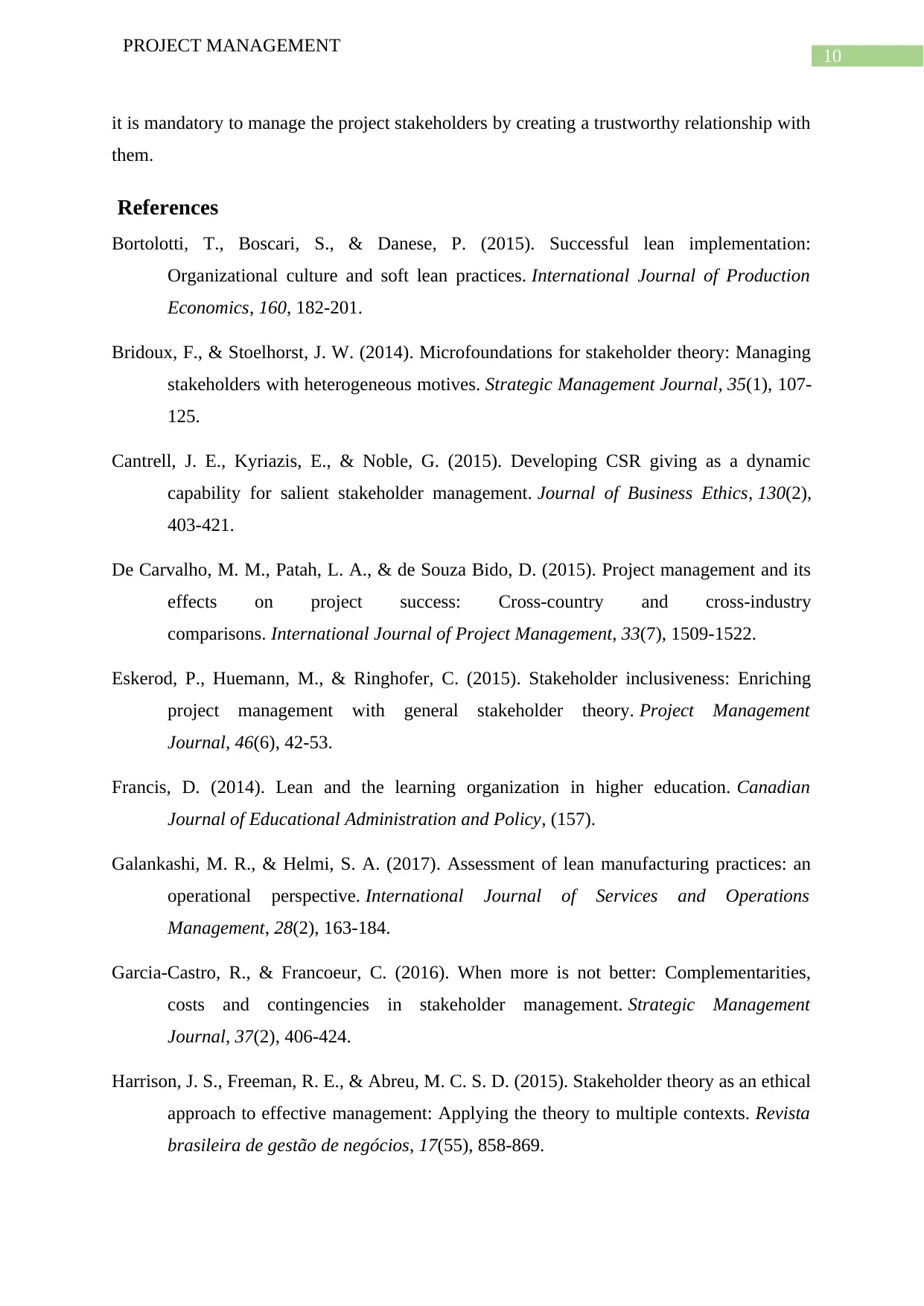
10
PROJECT MANAGEMENT
it is mandatory to manage the project stakeholders by creating a trustworthy relationship with
them.
References
Bortolotti, T., Boscari, S., & Danese, P. (2015). Successful lean implementation:
Organizational culture and soft lean practices. International Journal of Production
Economics, 160, 182-201.
Bridoux, F., & Stoelhorst, J. W. (2014). Microfoundations for stakeholder theory: Managing
stakeholders with heterogeneous motives. Strategic Management Journal, 35(1), 107-
125.
Cantrell, J. E., Kyriazis, E., & Noble, G. (2015). Developing CSR giving as a dynamic
capability for salient stakeholder management. Journal of Business Ethics, 130(2),
403-421.
De Carvalho, M. M., Patah, L. A., & de Souza Bido, D. (2015). Project management and its
effects on project success: Cross-country and cross-industry
comparisons. International Journal of Project Management, 33(7), 1509-1522.
Eskerod, P., Huemann, M., & Ringhofer, C. (2015). Stakeholder inclusiveness: Enriching
project management with general stakeholder theory. Project Management
Journal, 46(6), 42-53.
Francis, D. (2014). Lean and the learning organization in higher education. Canadian
Journal of Educational Administration and Policy, (157).
Galankashi, M. R., & Helmi, S. A. (2017). Assessment of lean manufacturing practices: an
operational perspective. International Journal of Services and Operations
Management, 28(2), 163-184.
Garcia‐Castro, R., & Francoeur, C. (2016). When more is not better: Complementarities,
costs and contingencies in stakeholder management. Strategic Management
Journal, 37(2), 406-424.
Harrison, J. S., Freeman, R. E., & Abreu, M. C. S. D. (2015). Stakeholder theory as an ethical
approach to effective management: Applying the theory to multiple contexts. Revista
brasileira de gestão de negócios, 17(55), 858-869.
PROJECT MANAGEMENT
it is mandatory to manage the project stakeholders by creating a trustworthy relationship with
them.
References
Bortolotti, T., Boscari, S., & Danese, P. (2015). Successful lean implementation:
Organizational culture and soft lean practices. International Journal of Production
Economics, 160, 182-201.
Bridoux, F., & Stoelhorst, J. W. (2014). Microfoundations for stakeholder theory: Managing
stakeholders with heterogeneous motives. Strategic Management Journal, 35(1), 107-
125.
Cantrell, J. E., Kyriazis, E., & Noble, G. (2015). Developing CSR giving as a dynamic
capability for salient stakeholder management. Journal of Business Ethics, 130(2),
403-421.
De Carvalho, M. M., Patah, L. A., & de Souza Bido, D. (2015). Project management and its
effects on project success: Cross-country and cross-industry
comparisons. International Journal of Project Management, 33(7), 1509-1522.
Eskerod, P., Huemann, M., & Ringhofer, C. (2015). Stakeholder inclusiveness: Enriching
project management with general stakeholder theory. Project Management
Journal, 46(6), 42-53.
Francis, D. (2014). Lean and the learning organization in higher education. Canadian
Journal of Educational Administration and Policy, (157).
Galankashi, M. R., & Helmi, S. A. (2017). Assessment of lean manufacturing practices: an
operational perspective. International Journal of Services and Operations
Management, 28(2), 163-184.
Garcia‐Castro, R., & Francoeur, C. (2016). When more is not better: Complementarities,
costs and contingencies in stakeholder management. Strategic Management
Journal, 37(2), 406-424.
Harrison, J. S., Freeman, R. E., & Abreu, M. C. S. D. (2015). Stakeholder theory as an ethical
approach to effective management: Applying the theory to multiple contexts. Revista
brasileira de gestão de negócios, 17(55), 858-869.
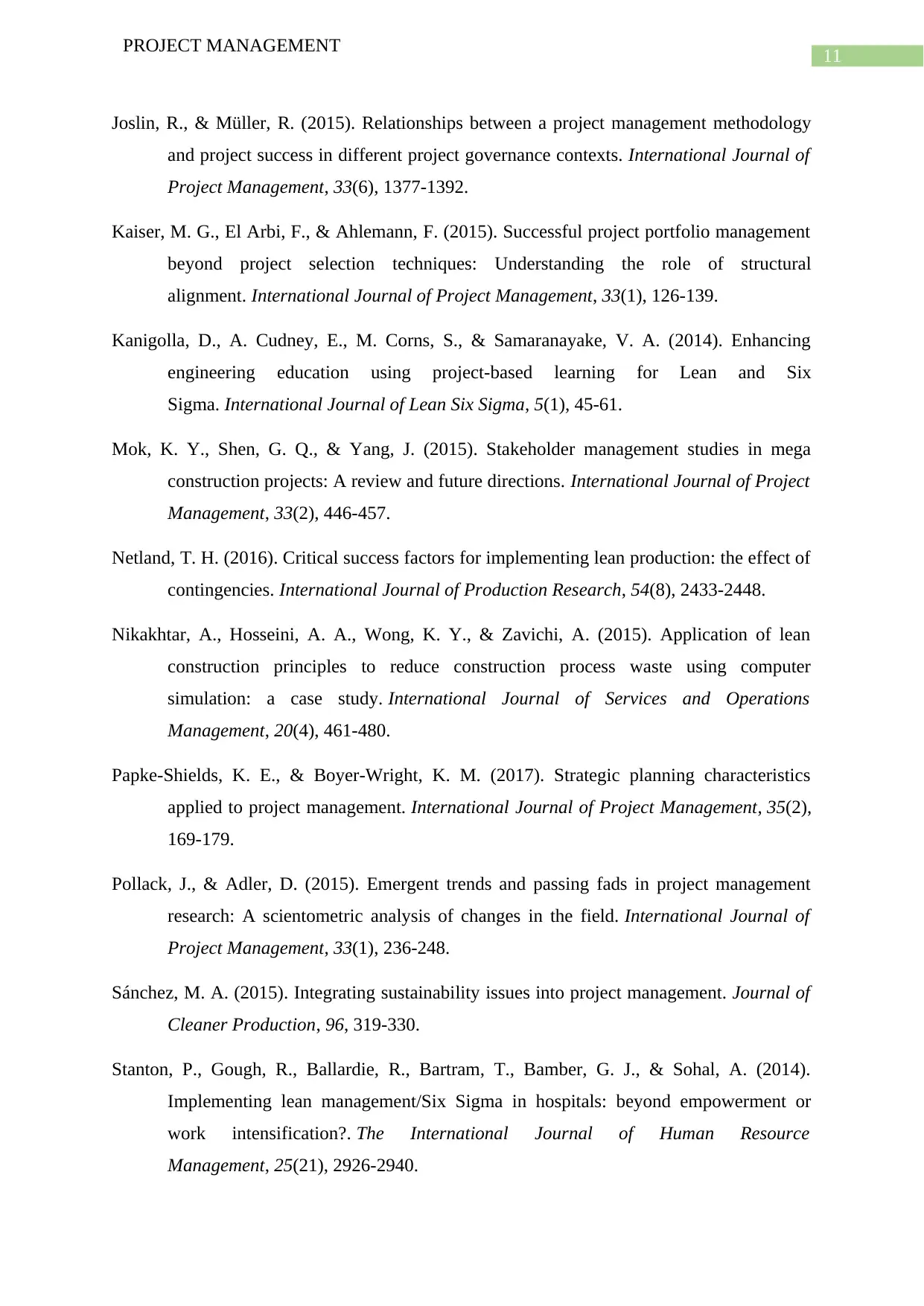
11
PROJECT MANAGEMENT
Joslin, R., & Müller, R. (2015). Relationships between a project management methodology
and project success in different project governance contexts. International Journal of
Project Management, 33(6), 1377-1392.
Kaiser, M. G., El Arbi, F., & Ahlemann, F. (2015). Successful project portfolio management
beyond project selection techniques: Understanding the role of structural
alignment. International Journal of Project Management, 33(1), 126-139.
Kanigolla, D., A. Cudney, E., M. Corns, S., & Samaranayake, V. A. (2014). Enhancing
engineering education using project-based learning for Lean and Six
Sigma. International Journal of Lean Six Sigma, 5(1), 45-61.
Mok, K. Y., Shen, G. Q., & Yang, J. (2015). Stakeholder management studies in mega
construction projects: A review and future directions. International Journal of Project
Management, 33(2), 446-457.
Netland, T. H. (2016). Critical success factors for implementing lean production: the effect of
contingencies. International Journal of Production Research, 54(8), 2433-2448.
Nikakhtar, A., Hosseini, A. A., Wong, K. Y., & Zavichi, A. (2015). Application of lean
construction principles to reduce construction process waste using computer
simulation: a case study. International Journal of Services and Operations
Management, 20(4), 461-480.
Papke-Shields, K. E., & Boyer-Wright, K. M. (2017). Strategic planning characteristics
applied to project management. International Journal of Project Management, 35(2),
169-179.
Pollack, J., & Adler, D. (2015). Emergent trends and passing fads in project management
research: A scientometric analysis of changes in the field. International Journal of
Project Management, 33(1), 236-248.
Sánchez, M. A. (2015). Integrating sustainability issues into project management. Journal of
Cleaner Production, 96, 319-330.
Stanton, P., Gough, R., Ballardie, R., Bartram, T., Bamber, G. J., & Sohal, A. (2014).
Implementing lean management/Six Sigma in hospitals: beyond empowerment or
work intensification?. The International Journal of Human Resource
Management, 25(21), 2926-2940.
PROJECT MANAGEMENT
Joslin, R., & Müller, R. (2015). Relationships between a project management methodology
and project success in different project governance contexts. International Journal of
Project Management, 33(6), 1377-1392.
Kaiser, M. G., El Arbi, F., & Ahlemann, F. (2015). Successful project portfolio management
beyond project selection techniques: Understanding the role of structural
alignment. International Journal of Project Management, 33(1), 126-139.
Kanigolla, D., A. Cudney, E., M. Corns, S., & Samaranayake, V. A. (2014). Enhancing
engineering education using project-based learning for Lean and Six
Sigma. International Journal of Lean Six Sigma, 5(1), 45-61.
Mok, K. Y., Shen, G. Q., & Yang, J. (2015). Stakeholder management studies in mega
construction projects: A review and future directions. International Journal of Project
Management, 33(2), 446-457.
Netland, T. H. (2016). Critical success factors for implementing lean production: the effect of
contingencies. International Journal of Production Research, 54(8), 2433-2448.
Nikakhtar, A., Hosseini, A. A., Wong, K. Y., & Zavichi, A. (2015). Application of lean
construction principles to reduce construction process waste using computer
simulation: a case study. International Journal of Services and Operations
Management, 20(4), 461-480.
Papke-Shields, K. E., & Boyer-Wright, K. M. (2017). Strategic planning characteristics
applied to project management. International Journal of Project Management, 35(2),
169-179.
Pollack, J., & Adler, D. (2015). Emergent trends and passing fads in project management
research: A scientometric analysis of changes in the field. International Journal of
Project Management, 33(1), 236-248.
Sánchez, M. A. (2015). Integrating sustainability issues into project management. Journal of
Cleaner Production, 96, 319-330.
Stanton, P., Gough, R., Ballardie, R., Bartram, T., Bamber, G. J., & Sohal, A. (2014).
Implementing lean management/Six Sigma in hospitals: beyond empowerment or
work intensification?. The International Journal of Human Resource
Management, 25(21), 2926-2940.
⊘ This is a preview!⊘
Do you want full access?
Subscribe today to unlock all pages.

Trusted by 1+ million students worldwide
1 out of 13
Related Documents
Your All-in-One AI-Powered Toolkit for Academic Success.
+13062052269
info@desklib.com
Available 24*7 on WhatsApp / Email
![[object Object]](/_next/static/media/star-bottom.7253800d.svg)
Unlock your academic potential
Copyright © 2020–2025 A2Z Services. All Rights Reserved. Developed and managed by ZUCOL.





